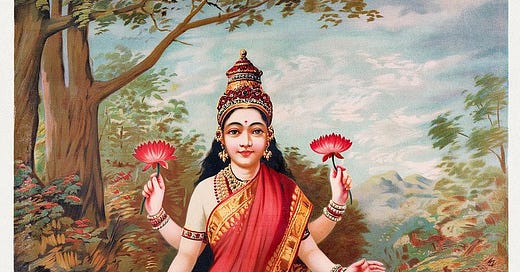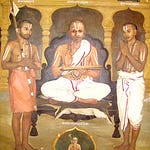As we begin the holy celebration of Navarātrī in the Gregorian year of 2024, I hope to share some verses every day from the Śrīvaiṣṇava tradition in praise of the Supreme Goddess Mahālakṣmī. For the first four days, I plan to share one verse from the Catuḥ-Ślokī of Swāmī Āḷavandār.
I have posted a full recitation of the Catuḥ-Ślokī on YouTube here.
On the Catuḥ-Ślokī of Swāmī Āḷavandār
The Catuḥ-Ślokī is the earliest Sanskrit stotra in the Śrīvaiṣṇava sampradāya (tradition) that is dedicated primarily to the goddess Mahālakṣmī as the Supreme Co-Divinity alongside Her eternal spouse, Lord Nārāyaṇa. Although just four verses long, it is a distillation of the tradition’s full perspective on the Goddess, and indeed all the subsequent stotras about Her in the Śrīvaiṣṇava tradition can be seen as elaborations of ideas already expressed or implicit in the Catuḥ-Ślokī itself.
The four verses of the Catuḥ-Ślokī and the four adhyāyas of the Brahma-sūtras
The ācāryas of the Śrīvaiṣṇava tradition have lavished a tremendous amount of interpretive attention to the verses of the Catuḥ-Ślokī. While we will limit ourselves in this series to just the translations of the four verses, in today’s introduction I do want to touch upon one important structural property of the Catuḥ-Ślokī: its four verses replicate the four-adhyāya structure of the Brahma-sūtras of Bhagavān Bādarāyaṇa. Swāmī Āḷavandār has thus brought to light the concealed, but core, role of Mahālakṣmī in the foundational text of Vedānta itself.
This is especially significant because Swāmī Āḷavandār tragically never managed to write his own commentary on the Brahma-sūtras. This responsibility he posthumously delegated to Swāmī Rāmānuja, who wrote the exquisite Śrī-Bhāṣya commentary on the text to establish the Viśiṣṭâdvaita school of Vedānta.
The topics of the four adhyāyas
What are the topics of these four adhyāyas? According to a verse in the Nyāya-kalāpa-saṅgraha of Senêśvarācārya, these are as follows:
pramāṇatā (I), tat-pratiyogi-bhaṅgaḥ (II), saṃrādhanaṃ (III) , tasya phalôpabhogaḥ (IV) | etāni saṃyak paricintitāni śāstre tv ihâ ’dhyāya-catuṣṭayena ||
(I) Validity and authoritativeness, (II) Refutation of opposing views, (III) Means of propitiation, and (IV) Enjoyment of the fruits thereof: All of these are properly and thoroughly analyzed in the Śāstra, through its four adhyāyas.
The traditional names for the four adhyāyas are as follows (and can be seen to be in conformity with the verse above):
Samanvaya (“harmonious reconciliation”): the multiplicity of the Upaniṣadic texts can be harmonized to yield an integrative picture of the Divine. The Vedic corpus is therefore authoritative (i.e., it has pramāṇatā) when it comes to providing us an insight into the Divine.
Avirodha (“non-contradiction”): the Vedāntic view is logical and well-founded and its opponents’ views are mistaken.
Sādhanā (“praxis”): there are specific ways (vidyās) laid out in the Upaniṣads that will result in liberation/self-realization.
Phala (“fruit”): the nature of this fruit, i.e., of liberation/self-realization, is also outlined in the Veda.
While there are of course many sharply different schools of thought when it comes to interpreting Vedānta (such as the Viśiṣṭâdvaita school of the Śrīvaiṣṇava tradition or the Kevalâdvaita of Śaṅkara or the Dvaita of Madhvācārya and many more in fact), all of them follow this same understanding of the four adhyāyas of the Brahma-sūtras when writing their commentaries on the text.
In praise of Swāmī Āḷavandār
Before commencing the recitation of the Catuḥ-Ślokī, it is customary to recite verses in praise of Swāmī Āḷavandār, its composer and one of the founding ācāryas of the Śrīvaiṣṇava tradition.
svādayann iha sarveṣāṃ Trayy-antârthaṃ sudurgraham | stotrayāmāsa yogîndras taṃ vande Yāmunâ-’’hvayam || yat-pādâ-’mbhoruha-dhyāna-vidhvastâ-’śeṣa-kalmaṣaḥ | vastutām upayāto ’haṃ Yāmuneyaṃ namāmi tam || namo namo Yāmunāya, Yāmunāya namo namaḥ | namo namo Yāmunāya, Yāmunāya namo namaḥ || स्वादयन्निह सर्वेषाां त्रय्यन्ता-ऽर्थं सुदुर्ग्रहम् । स्तोत्रयामास योगीन्द्रस्तं वन्दे यामुना-ऽऽह्वयम् ॥ यत्पादा-ऽम्भोरुह-ध्यान-विध्वस्ता-ऽशेष-कल्मषः । वस्तुताम् उपयातो ऽहं यामुनेयं नमामि तम् ॥ नमो नमो यामुनाय, यामुनाय नमो नमः । नमो नमो यामुनाय, यामुनाय नमो नमः ॥
Relishing the meanings (so impossibly difficult to grasp!) of the Vedānta, heart of the Triple Veda, the Lord of yogins wove them into songs of praise— To him, Yāmuna by name, do I bow down! By meditating on his lotus feet, which has utterly destroyed all of my sins I have attained the true nature of reality— To him, Yāmuna by name, do I bow down! Salutations, salutations galore to Yāmuna! To Yāmuna, salutations, salutations galore! Salutations, salutations galore to Yāmuna! To Yāmuna, salutations, salutations galore!
Catuḥ-Ślokī verse 1: The identity of the Supreme Goddess
kāntas te Puruṣottamaḥ, Phaṇi-patiḥ
śayyâ ’’sanaṃ vāhanaṃ
Vedâtmā Vihagêśvaro, yavanikā
Māyā jagan-mohinī |
BrahmÊśâ-’’di-sura-vrajaḥ sa-dayitas
Tvad-dāsa-dāsī-gaṇaḥ
«Śrīr» ity eva ca nāma te Bhagavati!
brūmaḥ kathaṃ tvāṃ vayam? || CŚ 1 ||
कान्तस्ते पुरुषोत्तमः, फणि-पतिः शय्या, ऽऽसनं वाहनं
वेदाऽऽत्मा विहगेश्वरो, यवनिका माया जगन्मोहिनी ।
ब्रह्मेशा-ऽऽदि-सुर-व्रजः स-दयितस्त्वद्दास-दासी-गणः
«श्रीर्» इत्येव च नाम ते भगवति! ब्रूमः कथं त्वां वयम् ? ॥Your beloved is the Supreme Lord The lord of snakes, Śeṣa, is Your bed and throne The lord of birds, Garuḍa, who is the soul of the Veda whose soul is the Veda is Your throne and vehicle Your curtain is the cosmos-occluding Māyā Brahmā, Śiva, and all the other gods plus their spouses are Your attendants And Your sacred, true name is Śrī: O Blessed Lady, How can we even begin to speak of You?
When Garuḍan himself, the Cosmic Bird who is the soul of the Vedas, is Her vehicle, and when all the gods and goddesses themselves joyfully act to bring Her visions to life, we can come to understand the Supreme Goddess Mahālakṣmī’s central role in the entire cosmos!
|| samasta-parivāra-sametāya Śrīman-Nārāyaṇāya namaḥ ||








Share this post